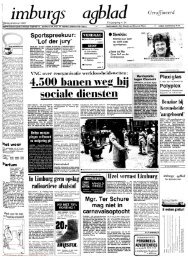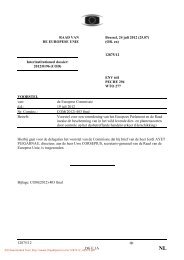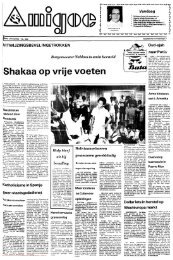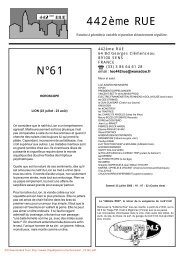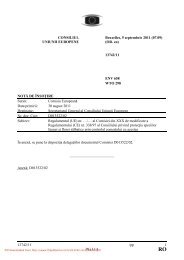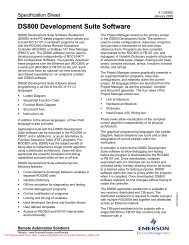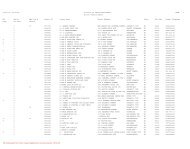American Recycler - Free PDF Hosting
American Recycler - Free PDF Hosting
American Recycler - Free PDF Hosting
You also want an ePaper? Increase the reach of your titles
YUMPU automatically turns print PDFs into web optimized ePapers that Google loves.
Section A Page 10 <strong>American</strong> <strong>Recycler</strong>, September 2008<br />
EQUIPMENT<br />
SPOTLIGHT<br />
N<br />
Single-stream collection of materials<br />
promises to greatly increase participation<br />
rates for municipal recycling programs. Consumers<br />
have been shown to nearly double the<br />
amount of material they divert away from<br />
landfills and into recycling in communities<br />
where single-stream recycling programs have<br />
been initiated.<br />
But commingling paper, glass, plastic,<br />
metals and other recyclables in a single curbside<br />
container also poses problems. While<br />
participation rates usually rise, so does the<br />
amount of waste generated by the recycling<br />
effort. Plus, the recycled material may not be<br />
as pure, which creates headaches for the<br />
glassmakers, paper plants and others who<br />
would reuse the materials.<br />
One solution to the single-stream<br />
conundrum is effective sorting of recyclable<br />
materials. At National Recovery Technologies,<br />
Inc. (NRT) in Nashville, Tennessee,<br />
engineering manager John Thomsen says<br />
their Multi Sort IR and Multi Sort IR ES<br />
Combo and Spyder machines are the most<br />
likely to go into single-stream applications.<br />
“The main issue we confront is that containers,<br />
plastic bottles and other similar sized<br />
objects end up in a stream that needs to be<br />
sorted by polymer and other characteristics,<br />
says Thomsen.” “The part of that that we do<br />
is to take out various polymers.”<br />
Sorting PET is usually done first with<br />
the Multi Sort IR using transmitted infrared.<br />
“We consider that a more reliable detection<br />
method. However, its use is limited to the<br />
transparent and translucent objects,” notes<br />
Thomsen. In a multi-stage process, materials<br />
are then immediately separated into transparent<br />
and opaque objects. The Spyder can be<br />
used for further separation. “Instead of separating<br />
the objects by color or transparency, it<br />
is looking at the actual polymers,” says<br />
Thomsen. For each detection system, controlled<br />
compressed air jets are used to physically<br />
separate materials from the rest of the<br />
stream.<br />
NRT has long sold sorting equipment to<br />
companies reclaiming mixed bales of recycling<br />
materials, and now is seeing good<br />
growth from municipal and other mixed<br />
recycling facilities. “Lately we’ve been very<br />
busy,” Thomsen says. “This has always been<br />
a cyclical business driven by the value of the<br />
commodities being processed and public<br />
interest and policy in recycling. Both of<br />
those are currently driving an increase in this<br />
kind of business.”<br />
At General Kinematics in Crystal Lake,<br />
Illinois, market director Bill Guptail says the<br />
company’s vibratory finger screeners and<br />
destoner classifiers are the main General<br />
Kinematics products sold for single-stream<br />
sorting applications. Finger screeners size<br />
items for better downstream recovery, while<br />
destoner classifiers are used to separate glass<br />
and other heavy items.<br />
“In a smaller facility where they’re going<br />
to run different items such as commercial<br />
waste, we’ll get a high percentage of old cardboard<br />
cartons (OCC) to go over the top of the<br />
screen and a high percentage of newspapers to<br />
go through,” he says. “If it’s traditional singlestream,<br />
where there’s no OCC, we’ll do a different<br />
size and get newspaper to go over the<br />
top of the screen and rigid commingled materials<br />
to go through.”<br />
Typically, materials are sent to optical<br />
sorters for further separation after General<br />
Kinematics’ vibratory screeners do some of the<br />
heavy lifting. “That improves the ability of the<br />
downstream equipment,” Guptail says of<br />
multi-step sorting that starts with General<br />
Kinematics equipment.<br />
Glass is a special problem in singlestream,<br />
and one addressed by Andela Products<br />
Ltd. in Richfield Springs, New York.<br />
Andela’s GP1 & GP2 glass pulverizers<br />
plus trammels reduce glass in<br />
mixed streams of recycling materials<br />
to 3/8th inch or less fragments and<br />
also removes sharp edges. Then the<br />
glass is easier to separate using simple<br />
screens. After dropping out of the<br />
stream, the mixed glass is turned into<br />
useful products such as roadbed,<br />
cover, mulch, pipe bedding as well as<br />
sandblasting & water filtration media.<br />
Cynthia Andela, president and<br />
chief operating officer, says, “In single-stream<br />
recycling, the glass is a lot<br />
of times forgotten. It’s hard to get it<br />
out of the stream because it’s all broken<br />
and mixed in with paper and<br />
other things. We can put our equipment<br />
in to drive the glass to smaller<br />
sizes, all the way down to 3/8th inch<br />
size and it doesn’t have any sharp<br />
edges. Then we can screen it out. You<br />
have simple mechanical separation.”<br />
Andela’s system capacities vary<br />
from 1 ton per hour to 20 tons per<br />
hour. All comprise three major steps.<br />
First, there is a hopper where material<br />
enters and is metered. Next, a pulverizer<br />
breaks down glass and rounds<br />
edges. Finally, there is a screening<br />
unit where glass falls through holes<br />
and out of the material stream. Conveyors<br />
tie it all together. Andela’s<br />
pulverizer breaks the glass only while<br />
leaving most other materials such as<br />
paper and plastic alone. “We put a<br />
magnet in the front of our systems to<br />
pull out the major steel. Soft cans and<br />
things like that aren’t a problem,”<br />
Andela says.<br />
Andela’s business has changed<br />
mostly in the way recycling materials<br />
are being handled. “There’s been<br />
a shift over the last four or five years<br />
to single-stream recycling because<br />
you have a higher recycling rate at<br />
• Automatic Sorting Technologies<br />
Optical Sorting Equipment<br />
Mechanical Sorting Screens<br />
Radial Stacking Scrap Conveyors<br />
Pdf downloaded from http://www.thepdfportal.com/0908_31652.pdf<br />
the curb,” she says. “But it also means the<br />
material is more mixed and the systems to<br />
separate it become more expensive and more<br />
involved. It’s brought to the forefront the<br />
necessity of providing for value-added products.”<br />
With that in mind, she spends much of<br />
her time developing and educating recyclers<br />
about viable applications for mixed glass<br />
recovered from single-stream recycling systems.<br />
At Karl W. Schmidt & Associates Inc. in<br />
Commerce City, Colorado, national sales<br />
manager Jeffrey Van Galder says the company<br />
integrates sorting equipment from several<br />
European manufacturers into the conveyor<br />
belt systems it makes for single-stream applications.<br />
Schmidt offers sorters based on technologies<br />
including magnetic, eddy current,<br />
disk screens, ballistic separators and optical.<br />
Andela Products Ltd.<br />
Magnetic Separation Systems, Inc.<br />
National Recovery Technologies, Inc.<br />
Sorting for<br />
single-stream<br />
recyclables<br />
Manufacturer List<br />
Andela Products Ltd.<br />
John Andela<br />
315-858-0055<br />
www.andelaproducts.com<br />
Austin AI, Inc.<br />
Kristine Keily<br />
512-837-9400<br />
www.austinai.com<br />
Eriez Magnetics<br />
Al Gedgaudas<br />
800-345-4946<br />
www.eriez.com<br />
General Kinematics<br />
Bill Guptail<br />
815-455-3222<br />
www.generalkinematics.com<br />
Green Machine Sales<br />
John Green<br />
800-639-6306<br />
www.greenmachinesales.com<br />
by Mark Henricks<br />
Hustler Conveyor Company<br />
Dave Guyton<br />
636-441-8600<br />
www.hustler-conveyor.com<br />
Karl W. Schmidt & Associates, Inc.<br />
Jeffrey B. Van Galder<br />
303-287-7400<br />
www.karlschmidt.com<br />
Magnetic Separation Systems, Inc.<br />
Felix Hottenstein<br />
615-781-2669<br />
www.magsep.com<br />
Marathon Equipment<br />
Renee Boman<br />
800-269-7237<br />
www.marathonequipment.com<br />
National Recovery Technologies, Inc.<br />
John Thomsen<br />
800-467-4678<br />
www.nrt-inc.com<br />
Smalis Conveyors<br />
Doug Smalis<br />
800-348-0765<br />
www.usaconvey.com<br />
Steel Belt, Roller Chain, Drag Chain,<br />
& Sliderbed Conveyors 303.287.7400 www.karlschmidt.com<br />
Ballistic separators appeal to customers struggling<br />
with disk separators that experienced frequent<br />
downtime due to wire, plastic ties and plastic<br />
bags wrapping around the disks and axles. “Ballistic<br />
separation applies high frequency agitation to<br />
the material through the use of paddles rather than<br />
disks,” he explains. “We wanted to have an option<br />
for people that were frustrated with disk screens.”<br />
One of Schmidt’s most active markets consists<br />
of smaller single-stream sorting centers processing<br />
up to 200 tons a day, Van Galder says. He<br />
looks for growth to continue. “There’s going to be<br />
an ongoing high demand for these materials and it<br />
comes back to collection and making it easy for the<br />
material to enter the recycling stream,” he says. “I<br />
think single-stream is going to keep on rolling.”



